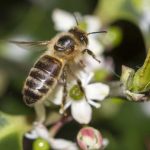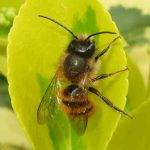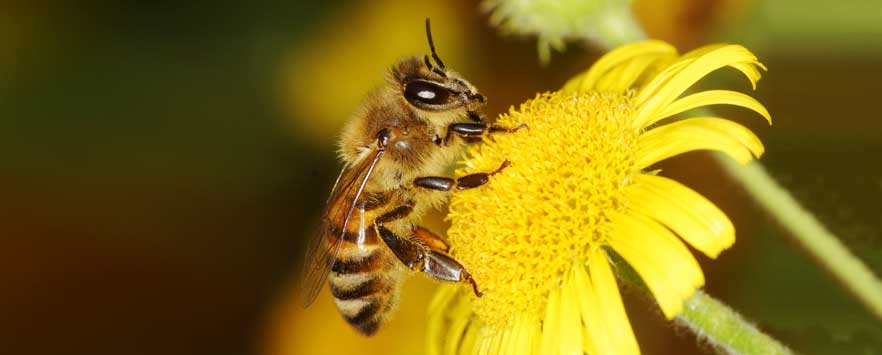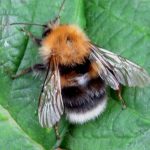Honey Bee Swarm Removal
Lady Mole Catcher is also qualified to deal with bees. As a professional wildlife management specialist, she can remove honey bee swarms and colonies from chimneys, walls, roofs and trees.
For full details on honey bee removal, please see:
Buzz-Off! – Live Honey Bee Removal
There are two types of bee, which may cause a problem.
Honey bees
 Honey bees have a thin, brown thorax and black abdomen with yellow-orange bands. They live in colonies but can cause problems when they swarm in large numbers. If provoked, honey bees can be aggressive with a painful sting, which can be life threatening to people with an allergy. Swarms happen when a queen bee leaves a colony along with thousands of worker bees to form a new colony elsewhere. They can colonise in any cavity but if they settle within a structure, they can cause damage or become a risk to public health.
Honey bees have a thin, brown thorax and black abdomen with yellow-orange bands. They live in colonies but can cause problems when they swarm in large numbers. If provoked, honey bees can be aggressive with a painful sting, which can be life threatening to people with an allergy. Swarms happen when a queen bee leaves a colony along with thousands of worker bees to form a new colony elsewhere. They can colonise in any cavity but if they settle within a structure, they can cause damage or become a risk to public health.
Masonry or Mortar bees
 Masonry or Mortar bees often burrow into mortar joints or crevices in brick or stone walls. They are solitary insects, unlike honey bees. With their reddish-brown bottom and black body, you’re most likely to see them flying in and out of walls or small holes in the ground. They make their nests in wall cavities and are able to tunnel through soft or damaged brick mortar – they do not cause structural problems.
Masonry or Mortar bees often burrow into mortar joints or crevices in brick or stone walls. They are solitary insects, unlike honey bees. With their reddish-brown bottom and black body, you’re most likely to see them flying in and out of walls or small holes in the ground. They make their nests in wall cavities and are able to tunnel through soft or damaged brick mortar – they do not cause structural problems.
The female masonry bee burrows into earth and soft rocks to lay her eggs from which new adults appear during the spring. Only one brood is created per year and you will only see them for just a few weeks.
Masonry/Mortar bees are not aggressive and are in fact harmless to humans. After the summer, most of the bees will leave and not return to the same nesting site the following year. Colonies formed in spring usually decline naturally by late July and as natural pollinators, they are very useful to gardeners and arable farmers.
Treatment and eradication is not required for Masonry and Mortar bees. By repointing soft mortar, filling brick holes and blocking gaps around window and door frames, they can be prevented from taking up residence at your property.
How do you know if you have Honey Bees on your property?
Feral honey bee swarms can set up home in chimneys and wall cavities, which can be a problem if they decide to swarm which will usually be a warm day during May to early June. Look out for bee activity in the spring and on warmer days when they become more active.
Why remove Honey Bees from property?
If a honey bee swarm is left and not collected quickly (within the same day), it could colonise a chimney, roof or wall. Removing bees due to nuisance, structural damage or work prevention reasons, is not an easy job and isn’t as straight forward as treating other insect nests.
A few things to consider if you have a bee colony on your property:
- The potential presence of over 50,000 bees that can sting
- Some people have an allergic and life-threatening reaction to bees (anaphylaxis)
- Presence of foraging wasps & hornets
- Leaking honey damage to your property
- Falling materials due to structural damage
- Bees swarming and entering your living space
A honey bee colony will continue to grow each year. The average size of a honey bee colony in the summer is around 50,000 bees, which has the potential to produce around six litres of honey!
“Honey bees are vitally important for flower pollination but with the mass use of insecticides and pesticides they have become endangered. The U.N. have reported that of the 100 crop species that provide 90 percent of the world’s food, more than 70 percent are pollinated by bees. It is therefore vitally important that we take care of our bees.”
Live Bee Removal
Swarming is a natural process in the life of a honeybee colony. It occurs when a large group of honeybees leaves an established colony to establish a new one and will occur throughout the last week of April to the middle of June.
When honeybees swarm, it is common for them to swarm onto bushes and trees. However, when bee swarms move into structures such as walls or chimneys, they will need to be removed for health and safety reasons.
A swarm is mobile because the bees are looking for a new location where they can make a honeycomb and establish a new colony. If a honeybee swarm is left and not collected quickly it could colonise chimneys, roofs or walls. You may even notice a dark sticky substance running down the chimney – this is honey and evidence of a bee colony in residence. Large numbers of bees within a colony can cause structural damage and become more problematic once a honeycomb structure has been created, as it is very difficult to remove safely. Removing honey beehives from chimneys, cavities and walls whilst keeping the bees alive is a dangerous task and should only be carried out by a bee removal specialist. Live bee removal does not involve insecticides. We need bees… without bees, there will be no Us!

Louise Chapman BA (Hons) PGCE
Norfolk’s very own Lady Mole Catcher®
Who I work with
- Householders in their gardens
- Farmers and Land Agents
- Outdoor Leisure Facilities
- Businesses
- Restaurants and Pubs
- Schools/Colleges
- Local Authorities
If you think you have a bee swarm on your property that is causing problems, get in touch with Louise to arrange for a site survey or consultation. Call 01603 25 99 45 or 07876 14 11 53 or email louise@ladymolecatcher.co.uk


